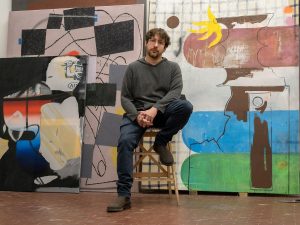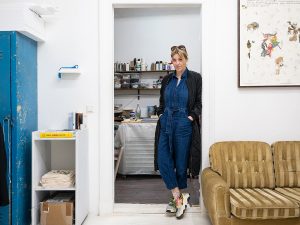Michele D’Aurizio (Chieti, 1985) is editor-in-chief of the international edition of “Flash Art”. He is also co-founder of the Gasconade project space in Milan. He has curated exhibitions at several galleries, including: the Galerie Balice Hertling in Paris; the Boatos Fine Arts in San Paolo; the Ellis King in Dublin; the Flash Art NY Desk in New York; the Fluxia in Milan; and the Grand Century in New York. He was curator-in-residence in 2012 at the Pastificio Cerere Foundation in Rome and co-curated the 2010-11 programme for the “Kaleidoscope” project space in Milan with Eva Fabbris. He has been Associate Editor of “Kaleidoscope” and editorial assistant for “Mousse”. He has had articles published in “Abitare”, “Flash Art”, “Kaleidoscope”, “Mousse” and “Spike”. He obtained an MA in Visual Arts and Curatorial Studies at the Nuova Accademia di Belle Arti – NABA in Milan, where he now lives.
Luigi Fassi (Turin, 1977) is Visual Arts Curator of the Steirischer Herbst Festival in Graz, Austria. From 2009 to 2012 he was artistic director of the ar/ge kunst Galerie Museum in Bolzano. He was the Helena Rubinstein Curatorial Fellow at the Whitney Museum ISP in New York in 2008-09, and has organized exhibitions internationally for various institutions, including: the Malmö Konstmuseum, Sweden; the Kunsthalle Helsinki, Finland; the Pori Art Museum, Finland; the ISCP, New York, USA; the Prague Biennial, Prague, Czech Republic; the GAM, Turin; the Museo Marino Marini, Florence; and the Fondazione Morra Greco, Naples. He has had articles published in “Artforum”, “Camera Austria”, “Mousse”, “Flash Art”, “Art Asia Pacific”, “Site” and “Klat” and is the author of the books Clement Greenberg. L’avventura del modernismo (Johan & Levi, 2011) and Time Out of Joint: Recall and Evocation in Recent Art (Yale University Press, 2009). Since 2010 he has been curator of the Present Future at Artissima, in Turin. In 2016 he will be a fellow on the Artist Research Trip Program in New York.
Simone Frangi (Como, 1982) has a French-Italian PhD in “Aesthetics and Theory of Art” and is a senior researcher in Philosophy and in Aesthetics and Theory of Art at the Centre National des Universités (Paris, FR). He is a curator and cultural researcher, and is artistic director of the Viafarini non-profit organization for the promotion of artistic research (Milan). Since 2013 he has been co-curator of the Live Works – Performance Act Award (Centrale Fies, Trento, IT) and since 2014 co-director of the nomad research programme A Natural Oasis? A Transnational Research Program run by the Little Constellation – Network of Contemporary Art, which focuses on Geo-cultural Micro-areas and Small States of Europe. Since 2013 he has been Professor of Theory and Current Issues in Contemporary Art at the Academy of Applied Arts and Design in Grenoble. In 2015 he was one of the five curators of the 10th Premio Furla award for Contemporary Art organized by the Furla Foundation. His recent curatorial projects include: Stage as a Social Platform (Teatro Continuo di Burri, Milan 2016); Pierre Michelon. Une histoire des décolonisations, telles qu’elles n’ont pas pu être, telles qu’elles ne sont pas encore (Centre d’Art Bastille, Grenoble 2016); Posthypnotic (Museion, Bolzano, 2015); Documentarism (Fondazione Pistoletto, Biella 2015); Kapwani Kiwanga (Viafarini, Milan 2015); Notes on Orientalism. Video Practices at the Age of Radical Difference (Viafarini, 2015); Performance Labour (Zhdk, Zurich 2014); Géographies Nomades (ENSBA, Paris 2012); Room, Freedom (Rosascape, Paris 2012).
Luca Lo Pinto (Rome, 1981) lives and works in Vienna and Rome. He is currently curator of the Kunsthalle in Vienna. He is founder and editorial director of the “NERO” magazine and publishing house. He has curated several exhibitions, including: Charlemagne Palestine (Kunsthalle Wien and Witte de With); Individual Stories (Kunsthalle Wien); Function Follows Vision, Vision Follows Reality (Kunsthalle Wien); Le Regole del gioco (Fondazione Achille Castiglioni); Pierre Bismuth (Kunsthalle Wien); Trapped in the Closet (Carnegie Library/FRAC Champagne Ardenne); Antigrazioso (Palais de Tokyo, Paris); Luigi Ontani-AnderSennoSogno (Museo H.C. Andersen); D’après Giorgio (Giorgio and Isa de Chirico Foundation). He has had articles published in numerous catalogues and international magazines and has edited books by artists such as Olaf Nicolai, Luigi Ontani, Emilio Prini, Alexandre Singh and Mario Garcia Torres. In 2012 he edited the publication Documenta 1955-2012. The Endless Story of Two Lovers. In 2014 he developed an editorial project based on the concept of a time capsule with the title 2014.
Matteo Lucchetti (Sarzana, 1984) is an art historian, freelance curator and critic. His principal curatorial projects include: Don’t Embarrass the Bureau! (Lunds Konsthall, Lund, 2014); Enacting Populism in Its Mediæscape (Kadist Art Foundation, Paris, 2012); and Practicing Memory (Fondazione Pistoletto, Biella, 2010). He has been curator in residence at the Para Site in Hong Kong, the Kadist Art Foundation in Paris and AIR in Antwerp. He is co-director of the Visible research project (Fondazione Pistoletto and Fondazione Zegna) and of the associated biennial prize for socially engaged artistic practice in a global context (2013, Van Abbemuseum, Eindhoven; 2015, Tate Liverpool; 2017, Queens Museum, New York). He is visiting professor at the Piet Zwart Institute in Rotterdam, the Sint Lucas School of Arts in Antwerp, the HISK in Ghent and the Accademia di Belle Arti di Brera in Milan. He has organized and taken part in several public lectures at various institutions, including at the Centre d’Art Contemporain, Geneva; the Steirischer Herbst, Graz; the Centre for Historical Reenactments, Johannesburg; and Creative Time, New York. He lives in Brussels where he co-directed the “Art as Something Else” programme in 2015 at the Galerie de l’ERG, with film screenings, talks and exhibitions with artists such as Giuseppe Campuzano, Chto Delat?, Marinella Senatore and Jonas Staal.
Marta Papini (1985, Reggio Emilia) lives and works in Italy. In 2010 she obtained her specialization degree with a research thesis on the relationship between art/the public/museums, which she carried out at the Whitechapel Gallery in London. Since November 2014 she has been Head of Research and Public Programs of the Centro Pecci, where, among other initiatives, she assisted the organizing committee in arranging the first Forum of Contemporary Art in Italy. Recent projects include: Shit and Die, organized with Maurizio Cattelan and Myriam Ben Salah (Palazzo Cavour, Turin, 2014); UN HOMME JUSTE EST QUAND MÊME UN HOMME MORT (Palais de Tokyo, Paris, 2013); and THESE PEANUTS ARE BULLETS (Family Business, New York, 2012). She was project manager of “TOILETPAPER magazine” (2012-2014) and was responsible for the editorial coordination of: Shit and Die (Damiani editore, 2014); 1968, (Deste Foundation, 2014); and Postmonument (Silvana editoriale, 2010), and has collaborated with several magazines, including “Purple Magazine”, “L’Officiel Italia” and “L’Uomo Vogue”.
Cristiana Perrella (Rome, 1965) is a curator and critic. From 1998 to 2008 she directed the Contemporary Arts Programme at The British School in Rome. From 2007 to 2009 she planned and developed the activities of an agency for the promotion of art among young people (SACS-Sportello per l’Arte Contemporanea in Sicilia) on behalf of RISO – the Sicily Museum of Contemporary Art, and was its curator for the first two years and again in 2012-2013. Since 2010, she has been responsible for the artistic section of the activities of the Golinelli Foundation in Bologna. As an independent curator, she has collaborated with Italian and international institutions including MAXXI, where she curated one of the exhibitions with which the museum opened in 2010, going on to collaborate on another three exhibition projects. From 2004 to 2010 she taught “The Phenomenology of Contemporary Art” at the Literature faculty of the University of Chieti. She is currently lecturer at the IED in Rome. She has had numerous articles and essays published, the most recent being an essay on Francesco Vezzoli for Rizzoli International, to be published in February 2016.
Domenico Quaranta (Brescia, 1978) is a critic and curator of contemporary art. He focuses in his work on how art responds to the changes brought about by the new means of communication and production in culture and society. He is one of the authors of Mass Effect (MIT Press, 2015). His essays, reviews and interviews have appeared in books, magazines, newspapers and on websites, including Flash Art and Artpulse. He has had two books published, Media, New Media, Postmedia (2010) and In My Computer (2011) and was co-editor of the book GameScenes. Art in the Age of Videogames (Milan 2006) with M. Bittanti. He has curated and co-curated various exhibitions in Italy and abroad, including: Connessioni leggendarie. Net.art 1995-2005 (Milan 2005); Holy Fire. Art of the Digital Age (Brussels 2008); RE:akt! (Bucharest, Ljubljana, Rijeka, Maribor, 2009-2010); Playlist (Gijon and Brussels 2009-2010); Collect the WWWorld. The Artist as Archivist in the Internet Age (Brescia 2011; Basel and New York, 2012); Unoriginal Genius (London 2014) and Mankind / Machinekind (Vienna 2015). He lectures at the Accademia di Belle Arti in Carrara and is artistic director of the Link Art Center, Brescia.
Denis Viva (Cividale del Friuli, 1979) teaches History of Contemporary Art at the University of Trento and is T.D. researcher at the University of Udine. In addition to his work as art historian, since 2008 he has also gained experience as a curator: he was artistic director of Palinsesti (San Vito al Tagliamento, 2008-2012), coordinated the “young galleries” section of the Premio Terna 2012 and was curator of temporary exhibitions at the Mart in Rovereto (2012-2014). He is currently curator of the Ibidem art and architecture projects at the Ado Furlan Foundation and the Paradoxa projects in far-eastern art at the Museum of Modern and Contemporary Art in Udine. In addition to his art history work, he has contributed to the scientific research for the general catalogues of some of the most important museums in Italy (the GAM in Turin, the Museum of the Twentieth Century in Milan, the Museum of Twentieth Century Art in Florence). His particular interest in Italian art is evident from his participation in www.capti.it (a project for digitalizing Italian art periodicals with the help of government research funding) and the research journal www.palinsesti.net.
Simone Ciglia (Pescara, 1982) has a PhD in History of Contemporary Art from the “Sapienza” University of Rome. He focuses mainly on late 20th century art and art criticism. He has curated various exhibitions and has written for catalogues and specialist magazines. He is a member of the Zanichelli editorial team, and worked with them on a school text book about the history of art. He has written some of the entries in Appendix IX of the Enciclopedia Italiana Treccani. He has worked as an assistant researcher for MAXXI – the National Museum of Arts of the 21st Century in Rome and is a correspondent for several magazines, including “Flash Art”. He is currently subject expert for “History of Contemporary Art” at the “Sapienza” University and the Roma Tre University in Rome.
Luigia Lonardelli (Bari, 1982) graduated in Florence in 2004 with a project supervising the archiving of the studio of artist Mario Mariotti, which was acquired by the Luigi Pecci Centre for Contemporary Art in Prato. The following year she took a Masters course in Management for Curators at the Valle Giulia Faculty of Architecture in Rome. She graduated in 2009 from the Specialization School in Siena with a study of the colour photography of Ugo Mulas. In 2012 she presented her doctoral thesis on the activities of the Incontri Internazionali d’Arte association during the 1970s, which is in the process of publication. Since 2005 she has collaborated with the Office for Contemporary Art, with responsibility for promoting Italian art and supervising the preparatory work for the opening of the MAXXI, where she began work as a researcher in 2010. Since 2011 she has been working in the curatorial department of the MAXXI, curating exhibitions dedicated to Marisa Merz (2012) and Alighiero Boetti (2013), among others.



